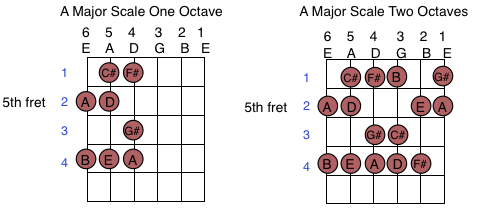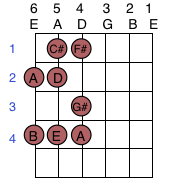This week in our playing-by-ear series guitar teacher Brad Mavin shares a process he uses for learning to play songs by ear on guitar.
A fun exercise that I like to do with students is to play along with a popular four chord song. Identify the key and make music using the scales that fit the tune.
For example “Halo” from Beyonce has the chords A, Bm, F#m, D. This is a I-ii-vi-IV chord progression in the key of A major. (note: Roman Numerals in lower case represent minor chords.)
It is a strong diatonic tune, which means that when you play outside the key it is really noticeable.
Having this in mind, a student can use this song to learn to play the A major scale all over the fretboard using his or her ears.
Start with the scale
Here’s A Major, the key scale for the song:

Play the notes of the scale up and down to get used to the fingering and sound.
Play the notes of the scale up and down on your instrument to get used to the fingering and sound.
It is a great idea to get used to playing through the changes with one octave first. Too many notes equals too many choices!
If you’re a guitar player you can see the fingering for the A major scale in the diagrams below. When playing these scales on guitar use one finger per fret. The blue numbers on the left side indicate the left-hand fingers. So the scale should start with your middle finger on the 5th fret low “E” string.

A Major Scale Fingering on Guitar
After you get used to the scales you can play them with the tune. Try to copy the rhythm of the melody line. You might even work out the notes or create your own new melody.
Follow the chords
You can make your solo sound more interesting and melodic by following the chords. How do we do this?
We need to find out which notes are in each chord. First start with the root note of each chord. You know the root note from the name of the chord. For example, the A major chord has the root note of A.
When you are comfortable playing root notes along with the song – move on to thirds!
What are thirds?
A third (3rd) is simply the third note of the scale. If we start on the root note of each chord and count up three notes we will land on the 3rd of the chord:
| Note 1 (“root”) | Note 2 | Note 3 (“3rd”) |
|---|---|---|
| A | B | C# |
| B | C# | D |
| F# | G# | A |
| D | E | F# |
Thirds are very important as they determine the quality of the chord: Major or Minor. Major and Minor chords have a very different character and a big influence on the sound of a song. So 3rds are important!

Play through the 3rd of each chord

Play the root and 3rd of each chord
So far we have found the root notes and 3rds. It is a good idea now to play through the scale and land on either a root note of the chord or the 3rd. Improvise your own lines! Use your ear to guide the resolution from one chord to the next.
Practice:
- Play the major scale up and down with the song
- Locate and play the root note of each chord
- Locate and play the 3rd of each chord
- Combine root notes and 3rds together
That’s probably enough to get started on for now!
In the next part we’ll look at using the fifth of each chord, forming triads, and some tips on extending this exercise to more keys and songs. Stay tuned…
Any questions or need help? Leave a comment below.









I have figured out the major E, G, C, D, A,and ,minor E, A. i was hoping to keep moving on. Could I get the next lessons. i am having a great time learning to play my guitar lessons.
Hi Eric – Great! You can find the next part right here: https://www.musical-u.com/learn/learn-to-play-by-ear-using-chord-tones-part-two/
Great lesson. really help tune the ear